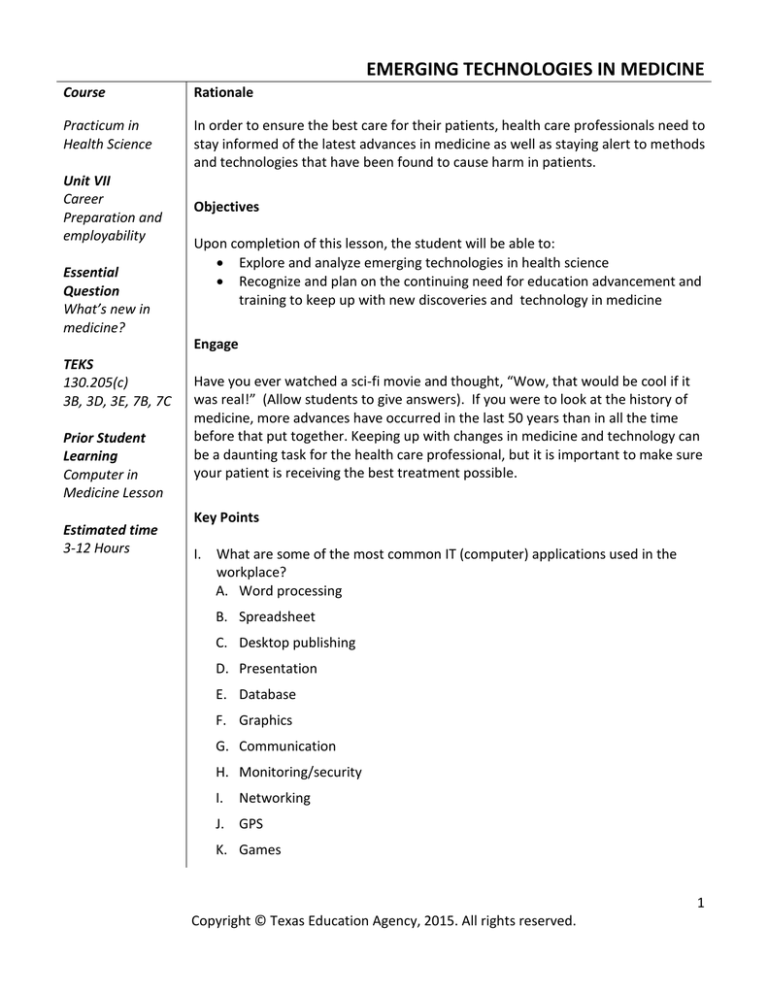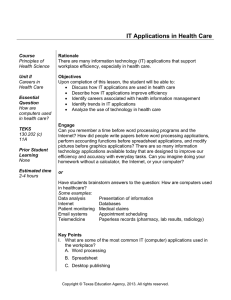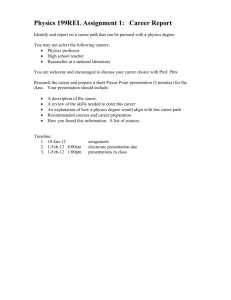EMERGING TECHNOLOGIES IN MEDICINE
advertisement

EMERGING TECHNOLOGIES IN MEDICINE Course Rationale Practicum in Health Science In order to ensure the best care for their patients, health care professionals need to stay informed of the latest advances in medicine as well as staying alert to methods and technologies that have been found to cause harm in patients. Unit VII Career Preparation and employability Essential Question What’s new in medicine? Objectives Upon completion of this lesson, the student will be able to: Explore and analyze emerging technologies in health science Recognize and plan on the continuing need for education advancement and training to keep up with new discoveries and technology in medicine Engage TEKS 130.205(c) 3B, 3D, 3E, 7B, 7C Prior Student Learning Computer in Medicine Lesson Estimated time 3-12 Hours Have you ever watched a sci-fi movie and thought, “Wow, that would be cool if it was real!” (Allow students to give answers). If you were to look at the history of medicine, more advances have occurred in the last 50 years than in all the time before that put together. Keeping up with changes in medicine and technology can be a daunting task for the health care professional, but it is important to make sure your patient is receiving the best treatment possible. Key Points I. What are some of the most common IT (computer) applications used in the workplace? A. Word processing B. Spreadsheet C. Desktop publishing D. Presentation E. Database F. Graphics G. Communication H. Monitoring/security I. Networking J. GPS K. Games 1 Copyright © Texas Education Agency, 2015. All rights reserved. L. Music M. Web design N. Search engines II. What do the applications do? A. Word processing -- letters, reports, documents, mail merge documents B. Spreadsheet -- data analysis, financial analysis, accounting C. Desktop publishing -- brochures, flyers, manuals D. Presentation -- educational presentations, business presentations E. Database -- employee information, company inventory, sales history, customer information F. Graphics -- photo enhancement, graphic design, animation, create digital artwork G. Communication -- email, instant messaging, record messages H. Monitoring/security -- ensure secure environment, prevent hacking, troubleshooting, manage service issues I. Networking -- enable devices to communicate J. GPS -- location finder, directions, mapping K. Search engines -- find information on the internet L. Games -- fun, leisure activities, educational activities, work simulation M. Music -- store recorded music, create music N. Web design -- manage webpages, create and edit web content III. Computers in health care A. Health informatics – intersection of information technology and health care B. Electronic Health Record (EHR) – an electronic version of a patient’s medical history that is maintained by a provider over time 1. May include: a. patient demographics b. progress notes c. problems d. medications e. vital signs f. past medical history g. immunizations h. laboratory data i. radiology reports 2. Generated and maintained within an institution, such as a hospital, clinic, or physician office 2 Copyright © Texas Education Agency, 2015. All rights reserved. Contains information from all the clinicians involved in the patient’s care 3. The information moves with the patient to the specialist, the hospital, the nursing home, or to a different state C. Administrative applications D. Billing and coding E. Clinical and special purpose systems F. Radiology and digital imaging 1. X-rays a. Traditional vs. digital x-ray b. Mammography 2. Ultrasound 3. Digital imaging a. Computerized tomography b. Magnetic resonance imaging c. Positron emission tomography 4. Bloodless surgery a. Interventional radiology b. Stereotactic radiosurgery c. Focused ultrasound surgery G. Other applications 1. Computer-assisted surgery a. Computer-assisting surgical planning b. Robotics c. Minimally invasive surgery i. endoscopic surgery ii. laparoscopic surgery 2. Prosthetics a. Myoelectric limbs b. Microprocessors c. Computer technology for vision and hearing 3. Pharmacy a. Prescription processing b. Computers and drug errors c. Access to patient and medicine data 4. Telemedicine – the use of telecommunications and information technologies to provide health care from a distance IV. Health Science Pathways A. Therapeutic Services – Careers in the Therapeutic Services pathway are focused primarily on changing the health status of the patient over time. 1. Pharmacist – How does electronically prescribing medication improve the pharmacy? 2. Physician’s Assistant – How do computers improve the patient’s experience in the physician’s office? How has technology contributed to 3 Copyright © Texas Education Agency, 2015. All rights reserved. more accurate and less invasive methods of diagnosis and treatment? B. Diagnostic Services – Careers in the Diagnostic Services pathway use tests and evaluations that aid in the detection, diagnosis, and treatment of diseases, injuries, or other physical conditions. 1. Radiologic Technologist -- How has technology contributed to more accurate and less invasive methods of radiologic exams? 2. Medical Technologist – How are various computer applications used in the laboratory? C. Health Informatics – Careers in the Health Informatics pathway include many different levels of health care-related employment. This pathway includes health care administrators who manage health care agencies, as well as those individuals who are responsible for managing all of the patient data and information, financial information, and computer applications related to health care processes and procedures. 1. Medical Records/ Health Information Manager -- How do computers improve the patient record? 2. Hospital Administrator -- How has the use of computer technology in this area changed over the last 15 years? What have been the advantages to the agency and to the patients? D. Support Services -- Careers in the Support Services pathway provide a therapeutic environment for the delivery of health care. Support Services offers a full range of career opportunities from entry level to management, including technical and professional careers. 1. Computer programmer -- How are various computer applications used in this agency? How do these applications improve healthcare for patients? 2. Facilities Manager – How has technology impacted quality control? E. Biotechnology Research and Development -- Careers in the Biotechnology Research and Development pathway involve bioscience research and development as it applies to human health. These scientists may study diseases to discover new treatments or invent medical devices used to directly assist patients or to improve the accuracy of diagnostic tests. 1. Biomedical Equipment technician -- What are examples of computerized medical instruments and equipment? 2. Biostatistician – How has technology impacted the statistical analysis of data? V. Health Information Management Careers A. Health Information Technology (HIT) -- The application of information processing involving both computer hardware and software that deals with the storage, retrieval, sharing, and use of health care information, data, and knowledge for communication and decision making. B. Health Information Management -- An allied health profession responsible for ensuring the availability, accuracy, and protection of the clinical 4 Copyright © Texas Education Agency, 2015. All rights reserved. information needed to deliver healthcare services and make appropriate healthcare-related decisions. ***END USER*** 1. The practice of maintenance and care of health records by paper-based and electronic means in hospitals, physician office clinics, health departments, health insurance companies, and other facilities that provide healthcare or maintenance of health records 2. Professionals who plan information systems, develop health policy, and identify current and future information needs. In addition, they may apply the science of informatics to the collection, storage, use, and transmission of information to meet the legal, professional, ethical, and administrative records keeping requirements of healthcare delivery. They work with clinical, epidemiological, demographic, financial, reference, and coded healthcare data. C. Health Informatics -- A discipline at the intersection of Information science, computer science, and healthcare. It deals with the resources, devices, and methods required to optimize the acquisition, storage, retrieval, and use of information in health and medicine. Health informatics tools include not only computers but also clinical guidelines, formal medical terminologies, and information and communication systems. 1. Using technology to store, share, and analyze health information 2. The management and communication of data, information, knowledge and wisdom Activity Choose an area of health care and research how new technology is being used in that field. Complete the “Researching Technology Questionnaire” form and report to the class. I. In groups of 2-3, choose an area of health care from the list and research and develop a side-by-side timeline for that area: one for the technology and advancements for that field and one for the educational requirements needed in order to work with the developed technology. Assessment Successful completion of the “Researching Technology Questionnaire” form and report to class Project Rubric for side-by-side timeline Materials Copy of “Research Technology Questionnaire” form and internet access Copy of list of fields students may choose from for side-by-side timeline and internet access 5 Copyright © Texas Education Agency, 2015. All rights reserved. Accommodations for Learning Differences For enrichment, the student will develop a new and innovative product that would benefit an area of technology/medicine. Development should include advertisement clarifying how product will benefit patient and area of medicine. For reinforcement, the student will contact and interview a professional organization in a selected area of medicine to discuss how they research new technology being introduced into that field of medicine. Discuss the advantages and disadvantage of technology to the patient and the profession. National and State Education Standards National Health Science Cluster Standards HLC 10.01 Technical Skills Healthcare workers will apply technical skills required for all career specialties. They will demonstrate skills and knowledge as appropriate. TEKS 130.205(c)(3)(B) research academic requirements for professional advancement such as certification, licensure, registration, continuing education, and advanced degrees 130.205(c)(3)(D) develop new problem-solving strategies based on previous knowledge and skills 130.205(c)(3)(E) evaluate performance for continuous improvement and advancement in health science 130.205(c)(7)(B) plan academic achievement for advancement in the health science industry 130.205(c)(7)(C) analyze emerging technologies in the health science industry. College and Career Readiness Standards English/Language Arts- V. Research A. Formulate topic and questions 2. Explore a research topic 3. Refine research topic and devise a timeline for completing work B. Select information from a variety of sources 1. Gather relevant sources 2. Evaluate the validity and reliability of sources 3. Synthesize and organize information effectively 4. Use source material ethically C. Produce and design a document 1. Design and present an effective product 2. Use source material ethically 6 Copyright © Texas Education Agency, 2015. All rights reserved. RESEARCHING TECHNOLOGY QUESTIONNAIRE Research an area of medicine using the internet, professional magazines, and if possible by interviewing a seasoned professional: Give a clear description of the area of medicine: Current types of certifications or licensures required for job entry to the area of medicine: Advance degrees and continuing education requirements for the area of medicine: Research what technology was used 10-20 years ago: What type of training did employees need in order to run equipment/technology: Research what technology is currently being used: Benefits of new technology for the professional: Benefits of new technology for the patient: Are there any disadvantages for either the professional or the patients? What methods can a professional use to get continuing education hours? 7 Copyright © Texas Education Agency, 2015. All rights reserved. SIDE-BY-SIDE TIMELINE PROJECT In groups of 2-3, choose an area of medicine from the list below and research and develop a side-byside timeline for that area. Do one for the technology and advancements for the field and one for the educational requirements needed in order to work with the developed technology. Professional List Acupuncture Athletic trainer/Sports medicine Audiologist Occupational Therapy Physical Therapy Prosthetics Respiratory Therapy Clinical Laboratory Scientist Dentist Forensic Science Nursing-(pick a specialty area) Pharmacy Biotechnologist Radiology Oncology Surgical Technology Vision Care ER/Trauma Medicine Cardiology Health Information Management 8 Copyright © Texas Education Agency, 2015. All rights reserved. PROJECT RUBRIC Student: ________________________ Date: __________________________ Scoring criteria 2 1 4 3 Needs Some Needs Much N/A Excellent Good Improvement Improvement Clearly/effectively communicates the main idea or theme. Reflects application of critical thinking. Information clearly provided in an organized and thoughtful manner. Strong examples used to describe the theme or objective. Illustrations follow a logical reasoning. Each image and font size is legible to entire audience. No spelling, grammatical or punctuation errors. NOTE: N/A represents a response to the performance which is "not appropriate." 9 Copyright © Texas Education Agency, 2015. All rights reserved.



